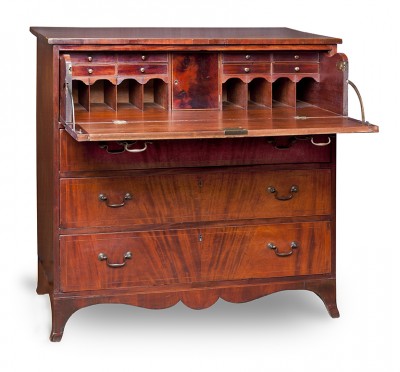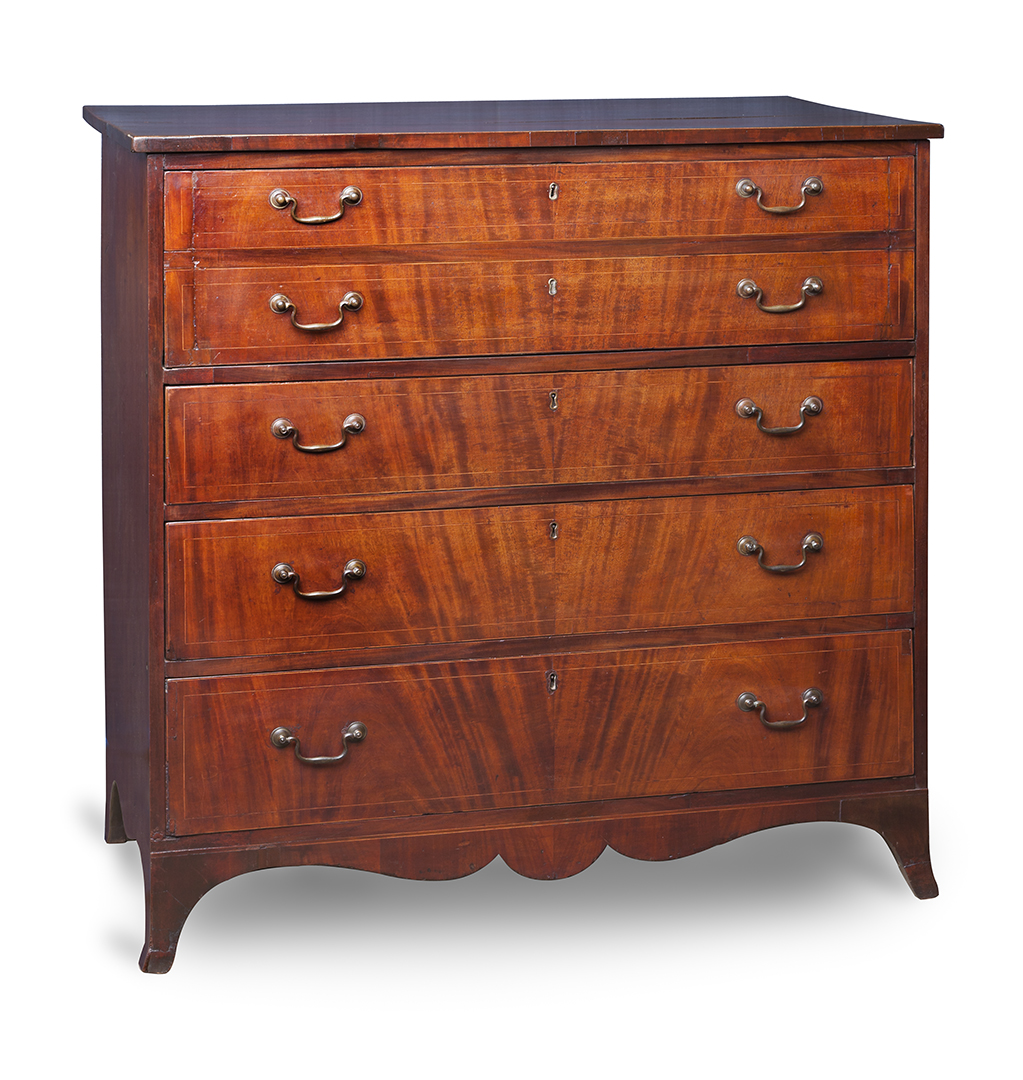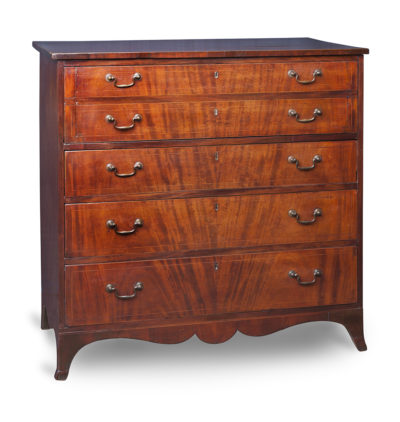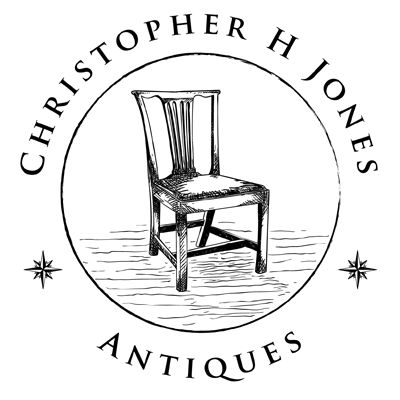Mahogany and Mahogany Veneers
Alexandria, Virginia
Attributed to the shop of John Muir (c.1770 -1815)
Circa 1790
41” wide, 21 ½” deep, 42” tall
Commentary: Scotsman John Muir was Alexandria’s preeminent cabinet maker during the final decades of the 18th century with a busy shop on South Royal Street where he employed a number on apprentices and journeymen. It is somewhat remarkable how few pieces of furniture can be authoritatively attributed to his shop in light of his lengthy career and the level of activity in his shop, to which his surviving account books attest. The principal point of reference for attributions to the Muir shop is a circa 1805 “circiolar beaurow” or swell front, chest of drawers signed “John Muir/ Maker/Alexandria/ DC” made for the Harper/Gregory/Howard family that is now in the collection of the Museum of Early Southern Decorative Arts (MESDA) (Acc. 5303.1) This chest remained in Alexandria in the possession of descendents of the original owner until 2008 when the chest became a part of the MESDA collections. Another related chest of drawers attributed to the Muir shop, now in a private Williamsburg collection, bears the signature of Hugh Muir, which could be either the name of the owner or maker. It is most likely that Hugh Muir was a relative although the name does not appear in contemporary census records. (Also attributed to Muir by MESDA based on the similar skirt and dovetailing is a fall front desk whose present location unknown, See MRF S-21875). A close inspection and comparison of the form, style, construction techniques and materials used in the signed chest and in the subject “secretary desk”, as the form was recorded in the cabinet maker’s account books; provide compelling evidence of their common origins in the shop of John Muir.
John Muir seems to have immigrated to the United States around 1790 and settled in Alexandria where he married Mary Lang, also a native of Scotland. (A John Muir appears in census records as early as 1787 so he may have arrived a bit earlier, and a William Muir, joiner, was active on the northern neck circa 1768 but it has not been possible to determine what if any relationship he may have had with John Muir.) With Mary he would have six children. Their oldest daughter, Jane, married James Green the son of cabinetmaker William Green, founder of the city’s first large scale furniture manufactory. The Muir’s son John would become a mayor of Alexandria in 1853. 
In October 1794 John Muir advertised with his new partner named Buckland that they had commenced their business as cabinet and chair manufacturers on Fairfax Street where they would produce goods in as neat and fashionable manner as found in Philadelphia or Baltimore. The partnership lasted until 1797 when it was dissolved “by mutual consent.” John Muir continued to operate his shop on Royal Street, advertising periodically for apprentices or to sell mahogany in quantity and appearing in a variety of local records up until his death in 1815. Portions of Muir’s account books from the period 1807 – 1815 have survived and provide a wealth of insight into the day to day flow of the cabinet maker’s affairs. The accounts detail the range of products manufactured by Muir from coffins to sideboards, dining tables, carved and fluted high post beds, desks, easy chairs, and a wide variety of breakfast and “caird” tables. The Muir shop also repaired all manner of furniture and such things as umbrella handles, locks, looking glass frames and frequently set up or moved beds and window cornices. Muir’s clientele included many of Alexandria’s most prominent citizens including Judge (Bushrod) Washington, Charles Lee, Richard B. Lee, Adam Lynn, John Wise, George Chapman, Laurence Lewis, Dr. Craik and many others.
Muir was a Mason and member of Brooke Lodge No 47 which was the second Masonic lodge established in Alexandria, as were cabinetmakers William and Walter Hannon who worked for Muir and took over Muir’s shop some time after his death. (The account book inventories the contents of the shop at Muir’s death but seem to indicate they were sold to a Daniel Payne even though Hannon advertised his continuation of the business shortly thereafter.) Presumably Mary sold what she could to the partnership as shortly after Muir’s death, Penn and Hannon advertised their cabinet business “at the large Brick House formerly occupied by John Muir, on royal streets.” A desk signed and dated 1815 by Walter Hannon, while stylistically later, features a secretary drawer that is virtually identical to the earlier desk by Muir, as are the overall dimensions. Muir’s surviving account books document that Hannon worked in the Muir shop either as an apprentice or journeyman prior to Muir’s death and utilized a standard shop pattern for the circa 1820 secretary, which descended in the Hooff family of Alexandria. (MESDA S-6302 )
Construction and Materials: Stylistically, the signed chest at MESDA and the secretary are quite similar. Both utilize mahogany veneers arranged in a dramatic mirrored pattern that creates a continuous upward and outward flowing movement across the front of the case. The veneers are carefully matched on each of the flush fit, cock beaded drawers that are graduated. Each of the cases rest on flared “French” feet that flow into very similar distinctively shaped skirts with the skirt shaping continuing below the solid side panels. Both cases have relatively thick, cross-banded tops with minimal overhangs. The similarities in woods, veneering technique, form, style and proportion are sufficiently pronounced that the two pieces could well have been made “in suite.” The close relationship continues to the details of construction. Both have broad, horizontal backing boards set and nailed into rabbets. The large continuous blocking securing the skirt to the underside of the case and shaping of the surviving foot blocking on both cases are distinctive and quite similar. Drawer stops, nailed in place on the blade tops are identical as are the size and form of the drawer dovetails which are quite fine, long and thin. The construction of the drawers is virtually identical, utilizing a combination of planned drawer bottoms slotted into rabetted side and fronts held in place by continuous glue blocks cut to 45 degree angles at the rear that provide evidence of construction practices unique to the Muir shop. The only significant differentiating point of construction is the presence of full dust boards in the secretary which are lacking in the chest. The weight and movement of the secretary drawer would have required bracing of the frame by dust boards that would have been unnecessary in the simpler chest.
Price: sold.



